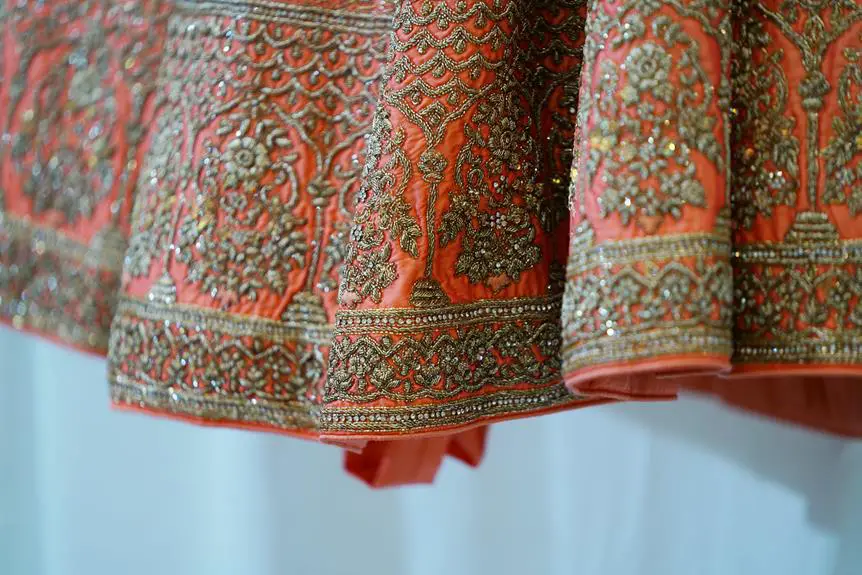Can you iron a satin dress without ruining it?
Yes, you can! Ironing a delicate satin dress may seem daunting, but with the right techniques, you can achieve a perfectly smooth finish without damaging the fabric. Understanding the nature of satin fabric and following proper ironing methods will help you master this task.
In this guide, you'll learn how to:
- Prepare the ironing surface
- Set the right heat for ironing
- Use the correct ironing techniques
- Apply finishing touches for a flawless result
Whether you're preparing for a special occasion or simply want to maintain the elegance of your satin dress, mastering the art of ironing satin will ensure your garment looks its best every time.
Key Takeaways
- Satin fabric is smooth and glossy, created using a high thread count weaving technique.
- Satin fabric can be made from silk, polyester, or acetate and is delicate, prone to snagging and damage.
- When ironing a satin dress, it is important to set the iron to a low heat setting and use a pressing cloth or clean cotton fabric for extra protection.
- To care for a satin dress, inspect seams and embellishments, spot-treat stains promptly, store folded in a breathable garment bag, and avoid direct sunlight, heat, and moisture.
Understanding Satin Fabric
You should know that satin fabric is a smooth and glossy material created using a weaving technique that produces a high thread count and a lustrous surface. This gives satin its characteristic sheen and luxurious feel.
Satin is often made from silk, but it can also be manufactured using polyester or acetate. One of the key properties of satin is its delicate nature; it's prone to snagging and can be easily damaged if not handled with care.
When it comes to fabric care, satin should typically be dry cleaned to maintain its luster and prevent damage. If you need to spot clean a stain, use a gentle detergent and cold water, and always test in an inconspicuous area first.
When storing satin garments, avoid folding them along creases to prevent permanent wrinkles. Instead, consider hanging them or rolling them in acid-free tissue paper.
Preparing the Ironing Surface
To iron a satin dress effectively, begin by laying a clean cotton cloth over the ironing board. This will provide a protective layer between the delicate satin fabric and the ironing surface. Here are some key points to keep in mind when preparing the ironing surface:
- Choosing the right ironing board
- Ensure that the ironing board is clean and free from any rough edges or dirt that could damage the satin fabric.
- Adjust the height of the ironing board to a level that's comfortable for you to work on, as this will allow for better control while ironing delicate fabrics.
- If possible, use an ironing board with a padded surface to provide extra cushioning and protection for the satin fabric.
Setting the Right Heat for Ironing
To iron a satin dress effectively, set the iron to a low heat setting to prevent damaging the delicate fabric. Using the right heat setting is crucial for achieving wrinkle-free results without causing any harm to the satin material. Here are some ironing tips to ensure you set the right heat for ironing your satin dress:
| Fabric Type | Recommended Heat Setting |
|---|---|
| Satin | Low |
| Silk | Low |
| Polyester | Low to Medium |
When ironing satin, it's essential to use a low heat setting to avoid scorching or burning the fabric. Start by testing a small, inconspicuous area of the dress with the iron to ensure that the heat setting is appropriate. If the fabric reacts well, proceed with ironing the rest of the garment. Additionally, consider placing a pressing cloth or a piece of clean cotton fabric between the iron and the satin dress to provide an extra layer of protection. By following these heat setting guidelines and ironing tips, you can safely achieve a smooth and polished look for your satin dress.
Ironing Techniques for Satin Dresses
When ironing a satin dress, ensure that you employ gentle, smooth strokes to avoid damaging the delicate fabric. Here are some ironing techniques for satin dresses to help you maintain the fabric's integrity and keep your garment looking flawless:
- Use a Low Heat Setting: Set your iron to the lowest heat setting to prevent scorching or melting the delicate satin fabric.
- Allow the iron to heat up properly before using it to avoid any temperature fluctuations that could damage the fabric.
- Consider placing a pressing cloth or a thin cotton towel over the satin dress to provide an additional layer of protection from direct heat.
- Iron Inside Out: Turn the satin dress inside out before ironing to protect the outer surface from any potential marks or shine caused by the iron.
- Avoid Excessive Pressure: Refrain from applying too much pressure when ironing satin as it can leave unwanted imprints on the fabric. Instead, let the weight of the iron do the work, and use gentle, gliding motions.
Following these fabric care and garment maintenance techniques will help you keep your satin dress looking elegant and well-preserved.
Finishing Touches and Care Tips
After ironing your satin dress, focus on carefully inspecting the seams and embellishments for any signs of damage or loose threads. Address any issues immediately to prevent further damage.
For stain removal, always spot-treat stains promptly using a gentle detergent or stain remover specifically formulated for delicate fabrics. Test any product on a small, inconspicuous area first to ensure it doesn't cause discoloration.
When it comes to storage, avoid hanging satin dresses for extended periods as this can lead to stretching or distortion. Instead, consider folding the dress and storing it in a breathable garment bag to protect it from dust and light.
Avoid exposing your satin dress to direct sunlight for extended periods to prevent color fading. Additionally, keep your dress away from sources of heat and moisture to maintain its integrity.
Frequently Asked Questions
Can I Use Steam When Ironing a Satin Dress?
When ironing a satin dress, you can use steam to remove wrinkles. However, be cautious as satin is delicate. Use low heat and a pressing cloth to prevent damage. Always test a small area first.
What Type of Iron Should I Use for Satin Fabric?
You should use a low-heat iron and avoid direct contact with satin fabric. Iron on the reverse side or place a cloth between the iron and the dress. Be cautious to preserve the delicate fabric.
Can I Iron a Satin Dress With Embellishments or Beading?
To iron a satin dress with embellishments or beading, use a low heat setting and place a pressing cloth between the iron and the embellishments to avoid damage. Gently press the fabric, taking care around the delicate details.
How Do I Prevent Shiny Iron Marks on Satin Fabric?
To prevent shiny iron marks on satin fabric, use a press cloth as a barrier between the iron and the fabric. This will protect the delicate satin and ensure a smooth, wrinkle-free finish without leaving any unwanted shine marks.
Can I Use Starch or Fabric Sizing on a Satin Dress Before Ironing?
Before ironing your satin dress, avoid using fabric sizing or starch as they can leave shiny marks. To iron satin without damaging it, use a low heat setting, a pressing cloth, and iron on the reverse side to prevent wrinkles.
- DIY Pillowcase Design: How to Transfer Images to Fabric at Home - June 25, 2025
- Upgrade Your Gear: How to Attach a Custom Label to a Fabric Gun Case - June 25, 2025
- How to Decorate a Fabric Pencil Case: 5 Creative Ideas for Students - June 25, 2025





